Here are my top 5 favorite tools for milling fresh flour. I’ve been milling my own flour, and over the past 25+ years. I’ve discovered tools that make this process both simple and satisfying.
I’m excited to share these 5 tools for milling fresh flour with you and why I love using them in my kitchen.
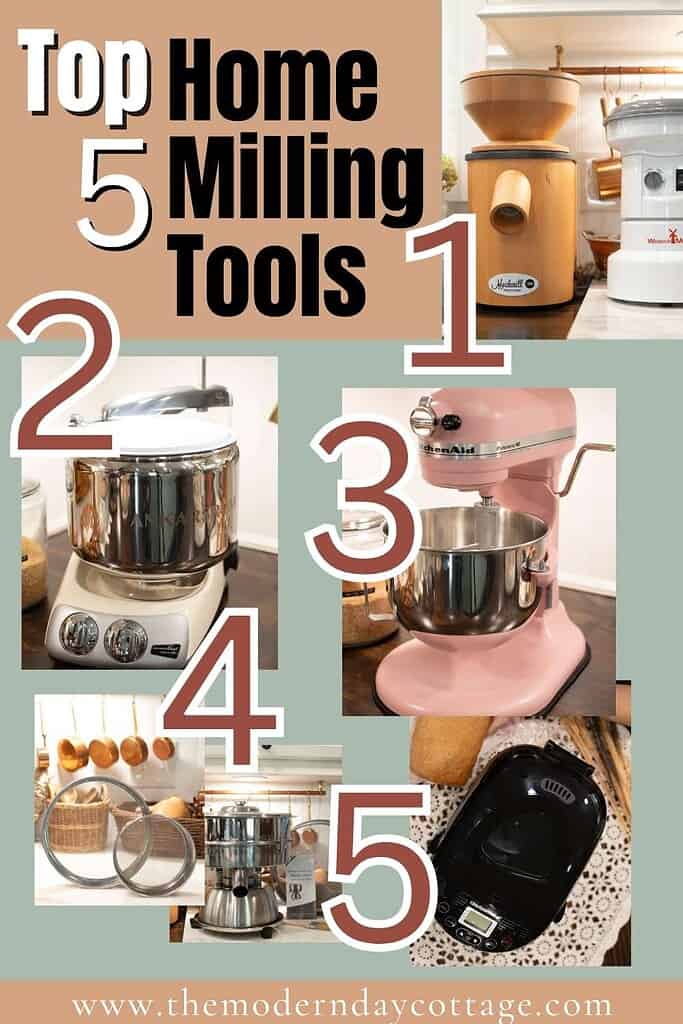
Incorporating freshly milled flour into your kitchen routine can be both simple and deeply rewarding. I hope this post gives you practical advice on tools and inspiration to begin wherever you are.
Using fresh milled flour changes everything. You start connecting with ingredients while learning new skills that truly enrich your baking experience.
With the right grain mill and a few trusted tools, home milling quickly becomes a natural part of your kitchen flow.
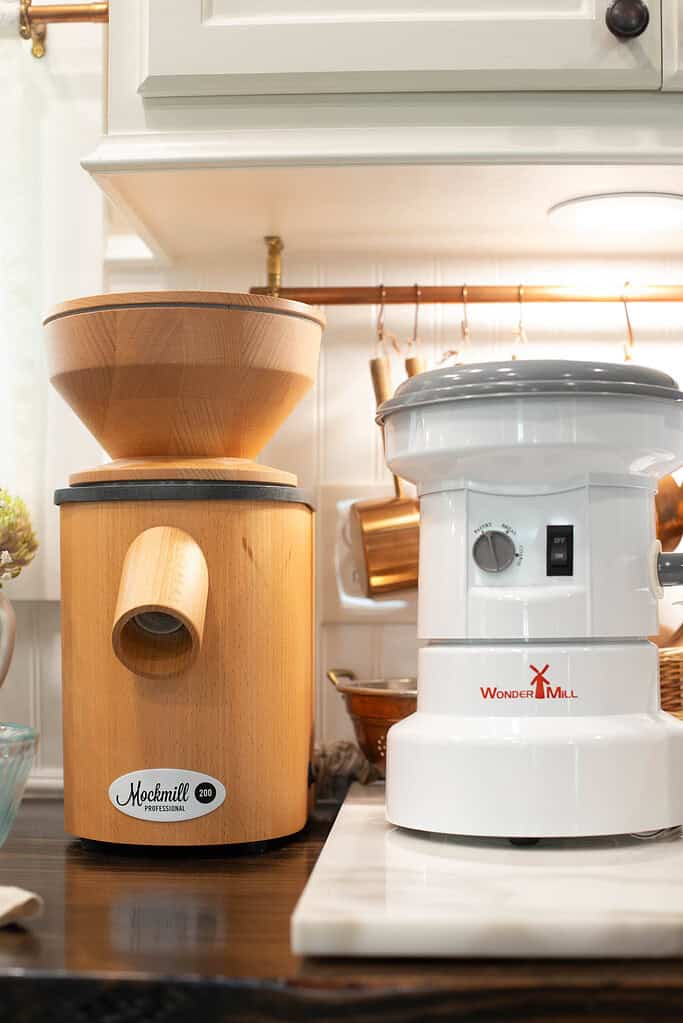
In my cottage kitchen, grinding wheat at home happens almost daily using hard white wheat, soft white wheat, and ancient grains.
The flavor and texture difference between store-bought flour and fresh ground flour is incredible. This is especially true when enjoyed with a warm, buttery slice of freshly baked whole wheat bread. You don’t need fancy tools to begin.
Even a high-speed blender(Vitamix) or a coffee grinder can work with dry grains. Every tool I’ve used over the years has helped build my confidence in making whole wheat flour in my home.
They also made it easier to master the milling process. After 25 years of baking with home-milled flour, I’ve learned what truly works in my own kitchen.
In this post, I’ll share my TOP five favorite tools for milling fresh flour at home. They help me turn wheat berries into flaky pastries and nourishing loaves.
The Mockmill
This beauty is the Mockmill grain mill Professional 200 Series—a wooden cased stone burr mill that proudly sits on my cottage kitchen counter.
Unlike the Mockmill 100, Mockmill 200, or Lino series, this model includes a powerful motor. It also has a cooling system for continuous milling.
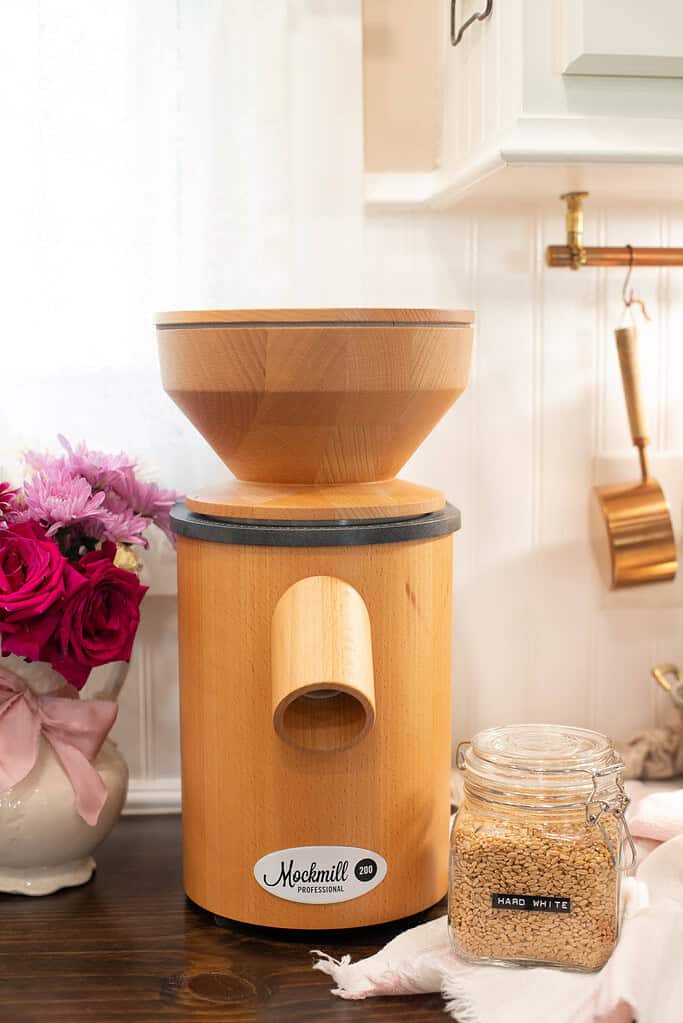
Its 600-watt motor grinds from fine flour to coarser textures at 200 grams per minute. This makes it the best grain mill for my everyday use.The 2.8-pound hopper works perfectly for large quantities of grain.
The stone burrs are ideal for milling both soft, hard wheat and so many more whole grains. The durable wooden housing beautifully complements my cozy cottage kitchen aesthetic. Its compact size and 20.7-pound build make it sturdy and reliable. The 12-year warranty gives me peace of mind.
Why I love it: It doesn’t need any attachments and adds warmth and coziness to my kitchen with its classic wooden design. It’s durability is also a plus.
The WonderMill
The WonderMill is an electric impact mill.
This mill is one of the most reliable and powerful impact mills available today, with a 1250-watt motor. It grinds up to 100 pounds of flour per hour without overheating, maintaining the nutritional value of your whole-grain flour.

Its stainless steel milling heads handle hard red wheat, durum wheat, rice flour, legumes, and more, including gluten-free grains.
This flour mill processes 24 ounces per minute, with a 3-pound hopper capacity, and it’s compact enough for smaller spaces. I’ve never had clogging issues to date.
It self-cleans and comes with a lifetime warranty and optional accessories like a flour bagger. This was my very first mill, back when it was called the Whispermill.
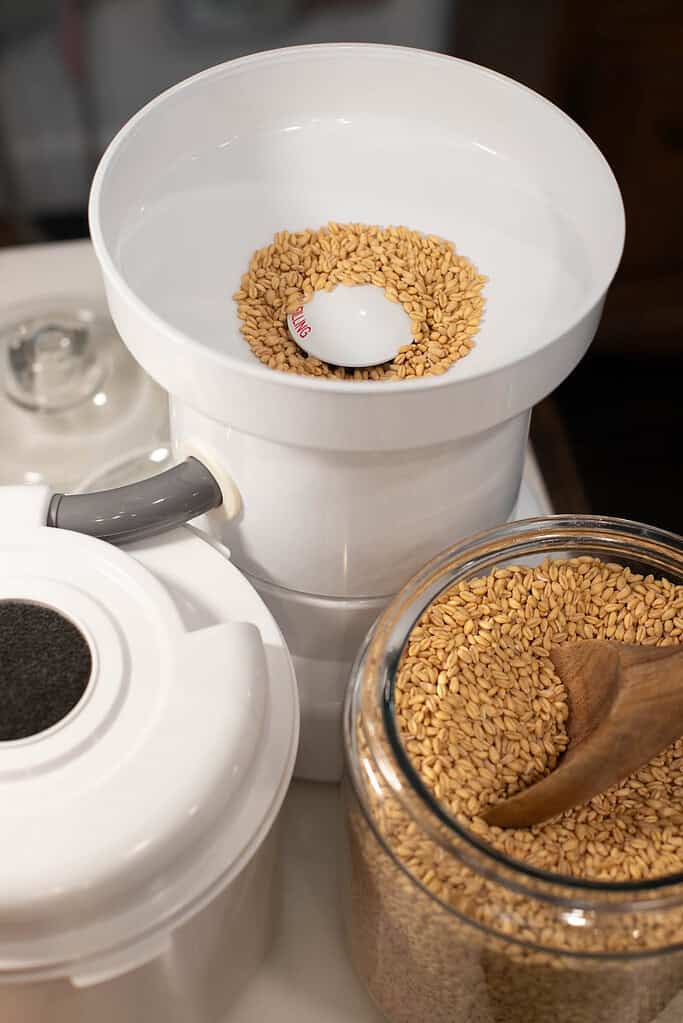
I gave my original to a 4H leader with 10 homeschooled kids, and I upgraded to the WonderMill. It has remained a durable workhorse. It also has a manual version—the Wonder Junior Deluxe. This manual version is great for off-grid situations, emergencies, or if you’re avoiding extra energy use.
Why I love it: It mills quickly, handles so much flour, and is my go-to backup for batch baking or bread recipes.
Manual + Electric Sifters
While freshly milled flour is hearty, I often prefer a lighter texture, especially for bread flour, cakes, and pastries.

I alternate between using a fine mesh sieve (manual) and an electric sifter, depending the size of the batch of flour I am sifting.
The manual method is my favorite for small batches. It brings back vivid memories of my grandmother, gently tapping the stainless steel drum, as flour softly falls through like powdered snow.
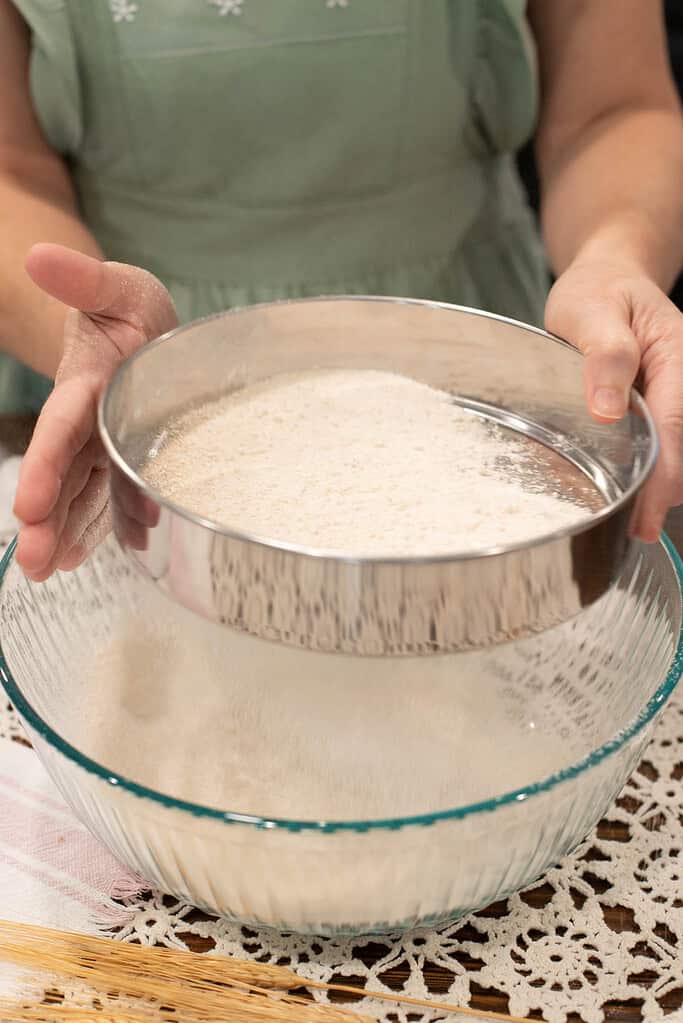
I use both #40, #50 and #60 sieves to get the finer grind I want. This is especially needed for all purpose flour using the #40 sieve, for bread flour #50 sieve, or cake and pastry flour using the #60 sieve.

For larger batches, my electric sifter makes the job quicker and smoother, especially when testing different grains. I have the #40, #50, and #60 sieves for my electric sifter as well. Those are my go to sizes for all my sifting flour needs.

The sifted-out outer layer (bran) goes in an airtight container in the freezer to save for muffins or sourdough. I almost always re-mill the bran in my Mockmill stone mill or My Wonder Mill and re-sift to get more flour.
You can find helpful tips for Converting Recipes to Freshly Milled Flour if you are adjusting your favorite recipes, and I also dive deeper into Sifting Fresh Milled Flour When It Matters Most to help you know when sifting really matters.
Why I love them: They give me total control over texture. Whether I’m gently sifting or flying through large flour batches, they are essential tools.
The Mixers I use Ankarsrum + KitchenAid Mixer
The KitchenAid
I started my mixer journey with the KitchenAid Tilt-Head, which worked for a while but struggled with dense whole wheat flour dough. I eventually upgraded to the KitchenAid Mixer with a 575-watt motor and a 7-quart stainless steel bowl.

This KitchenAid holds up better, but mine still needs breaks when mixing home-milled flour recipes.
I follow a two-minutes-on, two-minutes-off rhythm to avoid overheating, especially with hard wheat dough. If you’re looking for a quality mixer, it’s a good choice, especially during Black Friday sales at local retailers or online health food stores.
The Ankarsrum
However, this year, my husband gifted us the Ankarsrum Original Mixer, and I quickly fell in love with its capability.

It’s built in Sweden with a 600-watt motor, and the 7.4-quart stainless steel bowl can handle up to 11 pounds of dough. It includes all the essential attachments: roller, scraper, dough hook, beaters, and whisks.
I use it for sourdough bread recipes, freshly milled dough, fresh milled cakes, and even whipping eggs. It produces excellent gluten development and handles whole grain flour with ease.
Although it requires more hands-on attention, it is gentle on dough and ideal for large or small batches. I even made one of our favorite whole wheat recipe the day it arrived.
If you’re new to Ankarsrum, their YouTube Masterclass is a great place to check out thier tutorials and recipes. The Ankarsrum is priced around $749.95 with free shipping, while the KitchenAid runs about $529.99.
My Kitchen Aid is the Matte Dried Rose color if you’re in the market for a Pink Mixer. I love this color so much! Our front door is even painted pink. Pink is one of my favorite colors!
The Ank my husband purchased is light cream. *UPDATE* PS: I just got an email that the Ank is now in PINK!!! Now you, my dear cozy cottage friends, can get a PINK version!!
Both have their place in my kitchen. * Ruby Ann loves our pink KitchenAid for batch baking days, while I choose to use the Ankarsrum, learning all I can.
Why I love them: The Ankarsrum offers powerful, quiet mixing with superb gluten development and a generous capacity for large quantities of grain-based dough. The KitchenAid brings familiarity, flexibility, just take it slow, and give it breaks when needed using freshly milled flour.
The Bread Machine
Before I could afford a premium stand mixer, I started with a humble bread machine I bought on a budget. I found several brand-new, dented models at a return outlet for $10–$15 each and stocked up on four.
Those trusty machines helped me make whole wheat bread loaves for family and friends for years. Bread machines are excellent for those needing hands-free mixing, including home bakers with arthritis or limited mobility.

They’re also great for busy homemakers or businesswomen, and men needing a quick start with their own flour. I still keep THIS one in our pantry storage room and use it during busy seasons here at the Cottage.
On hectic days, I load the bread machine with freshly milled flour, water, sourdough starter, or yeast, salt, and any other ingredients needed for my recipe.
I set a timer, and in about 90 minutes, the dough is ready to bake if I’m using instant dry yeast. If I’m making sourdough, I transfer the dough into an oiled bowl, cover it, and do four rounds of stretch and folds. Then I let it bulk rise for another 1 to 2 hours, keeping in mind that freshly milled flour ferments much faster than store-bought flour.
Although you can bake inside the machine, I prefer removing the dough and baking it in the oven. This gives me 2 1lb. fluffy, beautiful loaves using the same amount of flour, compared to one condensed 2lb. loaf from the machine.

Bread machines are a helpful entry into baking with whole grain flour, especially if you’re new to the milling process and baking process.
They help you skip the learning curve while easily milling dry grains like whole wheat berries, brown rice, and many other whole grains into fresh baked breads.
Why I love it: It’s convenient, reliable, and an ideal starting point for anyone easing into breadmaking with freshly milled flour, especially busy people.
A Cottage Kitchen Tradition
These aren’t just tools, they’re part of a cozy, intentional tradition rooted in family and my love for real, healthy food.
Milling your own flour reconnects you to the land, improves the nutritional value, and supports a whole foods lifestyle.
These tools for milling fresh flour at home have earned their place in my daily kitchen rhythm. I use them with a variety of types of grains like hard red wheat, Einkorn wheat, soft white wheat, and many other whole grains.
Continue Your Freshly Milled Flour Journey
The Beginner’s Guide To Freshly Milled Flour Post
If you’re just getting started, you’ll love my Beginner’s Guide to Milling Fresh Flour at Home. It’s packed with everything I wish I knew when I first began home milling.
What Whole Grains To Use For Milling Flour At Home
You can also read more about What Whole Grains to Use for Milling Flour at Home, which breaks down the types of wheat and why I choose different ones for different recipes.
And if you’re thinking ahead to building a bulk pantry or keeping your grains fresh, don’t miss my full guide: Easy Tips for Storing Wheat Berries: Long and Short Term. I share everything I use and how I store over 300 lbs of wheat at a time in my cottage kitchen.
Tips For Converting Recipes to Freshly Milled Flour

If you have been wanting to bake with freshly milled flour but feel unsure where to start, I would love to share my full guide, Tips for Converting Recipes to Freshly Milled Flour. It is filled with simple, helpful tips to make the process feel easy, natural, and right at home in your own kitchen.
To dive even deeper into the why behind whole grains, I recommend exploring the Bread Beckers site. Sue, the founder, has a background in food science and offers helpful nutritional insights.

Every tool adds something special to my baking, from producing a finer grind to helping me prepare flour with a longer shelf life.
Choosing the best grain mill, storing your flour in an airtight container, and sourcing from places like Bread Beckers, Azure Standard, or health food stores can all simplify your journey.
Whether you’re exploring different grains, learning about protein content, or comparing stone burrs to impact mills, each step builds your confidence.
If you are just getting started with freshly milled flour, I would love to share a few more helpful posts with you, like Tips for Converting Recipes to Freshly Milled Flour and What Whole Grains to Use for Milling Flour at Home, to help you feel more confident in your baking journey.
The Top 5 Tools for Milling Fresh Flour Here at The Cottage
- 01. Mockmill Professional 200 – A powerful, stone-burr grain mill that gives me fine-to-coarse flour with ease and elegance.
- 02. WonderMill Electric Mill – My reliable backup for high-volume milling with a compact design and impressive power.
- 03. Manual + Electric Sifters – For creating lighter flour textures—my go-to sifters for cakes, pastries, and everyday bread flour.
- 04. Ankarsrum + KitchenAid Mixers – Two mixers, each with a special role in handling home-milled dough (and yes, I still use both!).
- 05. Bread Machine – A beloved classic in my kitchen for hands-free dough-making during busy or batch-baking seasons.
Continue Your Freshly Milled Flour Journey
If you’re anything like me, you want to know A to B and every why and how when I am learning a new skill, whether it’s in the kitchen or in the garden.
I love those tiny but mighty details, and it helps me troubleshoot on my own if I know all the ins and outs. I hope these posts help with just that when it comes to Freshly Milled Flour information. More to come soon…..
- #01 Beginner’s Guide to Freshly Milled Flour at Home
- #02 My Top 5 Favorite Tools for Milling Fresh Flour at Home
- #03 What Whole Grains to Use for Milling Flour at Home
- #04 Easy Tips for Storing Wheat Berries: Long and Short Term
- #05 Tips for Converting Recipes to Freshly Milled Flour
- #06 Sifting Fresh Milled Flour: When It Matters Most
- #07 Bread Flour Blend Using Freshly Milled Wheat Berries
- #08 Grinding Freshly Milled Wheat Berries for Homemade All-Purpose Flour
- #09 Baking Sourdough with Freshly Milled Flour at Home
- #10 Where To Buy Wheat Berries And Other Whole Grains
- #11 Homemade Cake and Pastry Flour Using Freshly Milled Flour

A Little Bit About Me
Hi, I’m Emily Rider, a cottage living lifestyle enthusiast who finds deep joy in slow, intentional living.
I’ve been milling my own flour and baking sourdough and fresh-milled recipes for over 25 years.
Through The Modern Day Cottage, I share the tools, techniques, and time-tested tips that have shaped my own baking journey, so you can build your own from-scratch rhythm, right where you are.
Whether it’s a nourishing loaf, a flaky pastry, or your very first sourdough starter, I hope to help you fall in love with the process, too.
When I’m not baking, you’ll find me tending our cottage garden, gathering rainbow eggs from our sweet heritage hens, sewing, crafting, homeschooling Ruby Ann, and doing my best to keep our home cozy and inviting.
Disclaimer: This post shares and reflects my personal experience baking with freshly milled flour at home for over 25+ years. It is intended for informational and inspirational purposes only. Please use your best judgment and consult a qualified professional for any dietary or health-related advice.


